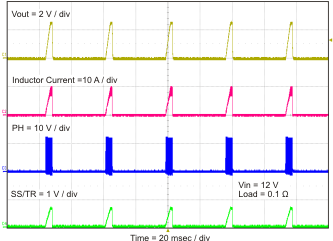SLVU379A August 2010 – August 2021
2.10 Hiccup Overcurrent Mode Operation
Figure 2-11 shows the TPS54521EVM-607 operating in a near shorted output (0.1 Ω load) condition. If the current in the high-side MOSFET reaches the current limit for 512 switching cycles in a row, the TPS54521 enters hiccup overcurrent protection and stops switching (hiccups) for the next 16384 cycles.
 Figure 2-11 TPS54521EVM-607 Overcurrent Hiccup Mode
Figure 2-11 TPS54521EVM-607 Overcurrent Hiccup Mode